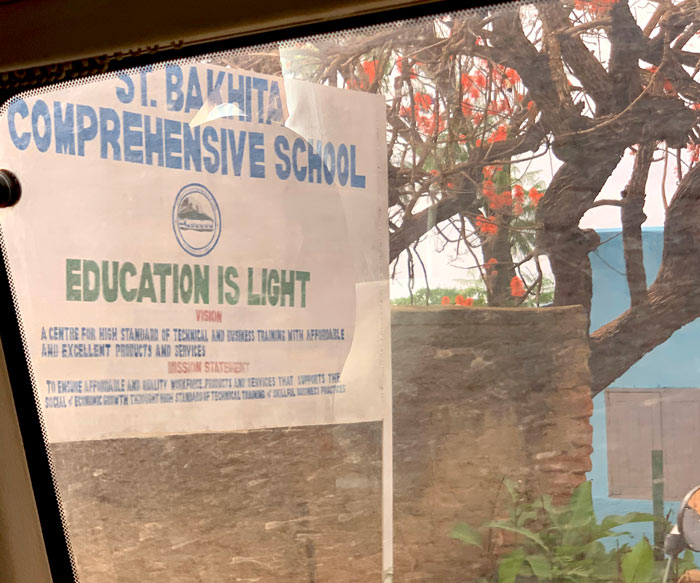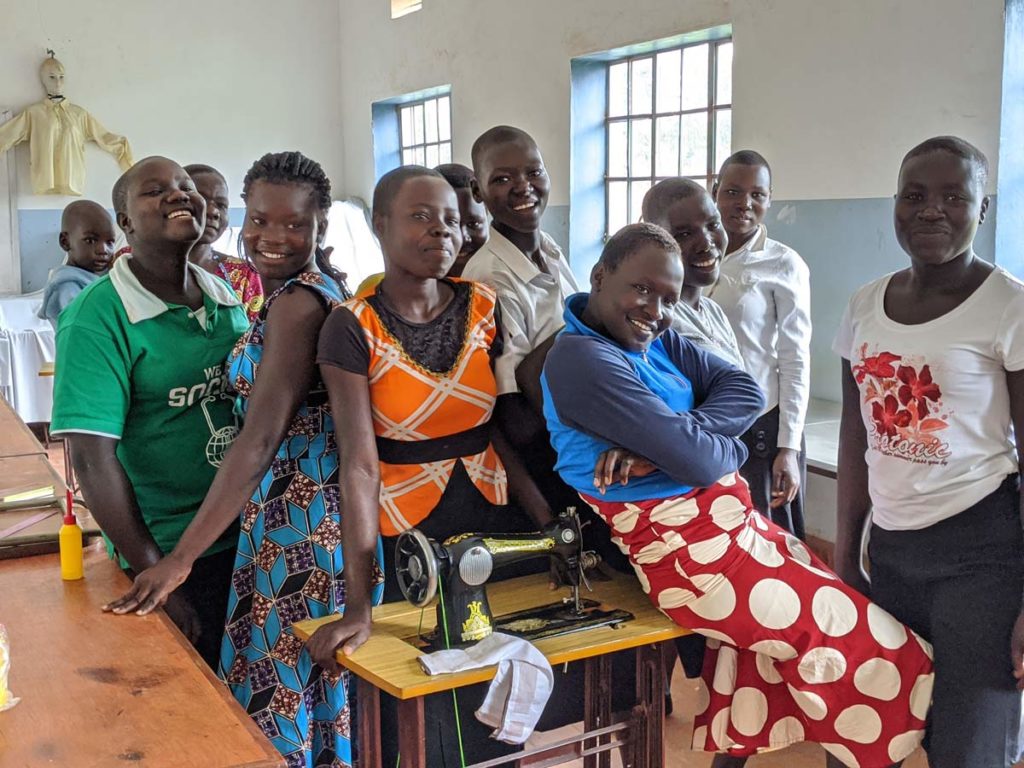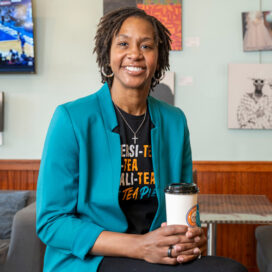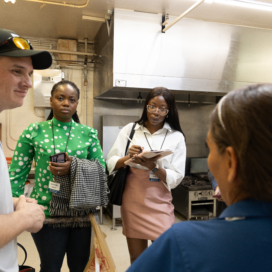The business of designing hope
Published: December 17, 2021 / Author: Carol Elliott

Sign for St. Bakhita’s through a car window. (Photo by Sophia Kartsonas)
Lynsee Ludwick’s first trip traveling outside of the U.S. is a doozy — a 16-hour flight from Chicago to Entebbe, Uganda, and then another 10 hours of being carted overland by truck before arriving at her final destination of Kalongo in the country’s northern region.
The Mendoza College of Business junior is traveling with 14 of her University of Notre Dame classmates during their winter break to visit people they’ve only become familiar with via Zoom, but who have occupied their thoughts and creative energies for the better part of the past year — the students of the St. Bakhita Vocational Training Center (SBVTC). The school opened in 2007 to help women rebuild their lives in the wake of tragic abductions by the violent Lord’s Resistance Army (LRA). As many as 30,000 children were victims of the LRA with abductions beginning in the late 1980’s and continuing for over a decade.
Ludwick is the incoming president of the Notre Dame Innovation for Impact student club, which has been involved in helping the school in its mission to empower women through education and training to transform their lives and the larger community. Impact for Innovation formed as an offshoot of the Innovation and Design Thinking class taught by management teaching professor Wendy Angst, which has been working with SBVCT since spring 2020.
Their efforts have been directed at three primary objectives: 1) helping young women gain access to education to empower them to build better futures, 2) addressing the social and economic devastation left by the LRA, particularly with special emphasis on young women as the vehicle to help heal their communities and improve prosperity, and 3) addressing Uganda’s growing deforestation crisis. (Read more about the Innovation and Design Thinking class’ work with St. Bakhita’s.)
“The Innovation for Impact club was born out of the passion of students from my Innovation and Design Thinking class,” said Angst. After spending a semester connecting with young women on the other side of the world, understanding the circumstances these young women were born into, our incredible Notre Dame students were committed to doing more.”
Angst noted that this club is unique in that we are focused on implementing ideas. “I tend to think of it as ‘running a business in the business school,’ although not all of our club members are students in Mendoza. On activities night we were blown away by the response with over 150 students signing up for the club!”
“I think students are excited about the opportunity to move beyond a recommendation and have an opportunity to roll up their sleeves and work on implementing their ideas to have a meaningful impact — moving from innovation to impact,” said Angst.
The club currently has projects spanning finance, technology, energy, curriculum, marketing and agriculture. Each project vertical has an Industry advisor, as well as a graduate student and undergraduate student lead. It has a real budget to work with and measures success by ideas implemented. For example, out of this year’s Innovation and Design Thinking class, 12 projects were pitched to club advisors, and $35,000 was granted to either begin immediate implementation or to continue testing and de-risking the concept.
During their trip, the students will get to see first-hand the impact of one of their newly launched SBVTC programs called Innovation Scholars, a funding effort to provide tuition support in the form of a work study model so students can attend the school and learn life-changing skills. The club has raised over $20,000 toward its fundraising goal, which is enough to provide tuition for nearly 40 students, and a full year’s salary for two teachers. Ultimately the club is looking to raise $112,000, which is the operating budget for the school full year, including tuition support.
Costs for the school may seem minimal by U.S. standards — annual tuition for one student is $260 and a teacher’s annual salary is about $5,000 — but it’s hard to overstate the potential impact of a program such as the Innovation Scholars.
“What we’re doing with this school is not just giving money, but empowering through education and through innovation,” said Ludwick. “Education, especially for women in this area, is a huge factor in the mobility and opportunities that they have.”
Many of the young women provide substantial financial support for their entire families, she added. If they attend school, their families potentially sacrifice the bride price they would receive if they marry. “So it’s really a difficult situation, but if we can alleviate that burden for them and educate these students and give them these opportunities, it’s a huge thing,” Ludwick said.
“After my first interview with Elizabeth and Victoria (two young women at St. Bakhita’s), I immediately walked out of the room I was Zooming in and told the first person I saw that I knew that I just did the coolest thing ever: interview a Ugandan girl,” said junior Kayleigh Wolff. “After this first interview, as I mentioned in my presentation, I feel that Elizabeth is my friend and my team and I are invested in helping to improve her life.”

A group of St. Bakhita’s students. (Photo by Wendy Angst)
During their 10-days in Uganda, the students will visit other vocational schools, meet with female entrepreneurs, and meet with the Secretary of Education and the Archbishop of Gulu. At Saint Bakhita’s, students will conduct design workshops and begin prototyping projects that the club and the Innovation and Design Thinking class has been working on.
The projects include helping with literacy assessments for the remote tutoring program that was piloted during the fall 2021 semester, helping to implement a chick hatchery from the “Chickens for Change” project proposed by the spring 2021 class, and working with students and staff on basic computer training in the recently launched Mary S. Pulido Technology Learning Center, which boasts 40 computers and 35 smartphones and is powered by 60 recently installed solar panels. Students will also get to meet their partners from the Archidiocese of Gulu and the students and teachers they’ve connected with via Zoom over the past semester.
“The connections made over Zoom have been life changing for students in Uganda and here at Notre Dame, but being in person and working hand in hand with the students and teachers is invaluable,” said Angst.
“This project has been the most impactful experience that I have been a part of at Notre Dame. said Wolff. “It opened my eyes to the fact that I can truly use my education to make a difference in the world. I have been told this many times before, but this class and this project is what opened my eyes to that reality.”
Madeline Smerdon (MBA ’22), who will also be traveling with the group, was interested in being part of the Innovation for Impact club because it aligned with her interests in entrepreneurship, educational development and design thinking. Once she began working on the St. Bakhita projects, however, she discovered a new perspective on entrepreneurship.
“Typically you think of entrepreneurship as something like a tech startup or innovative product offering where you need a lot of funding and innovation,” she said. “St. Bakhita’s or other efforts like this in impoverished areas show that it doesn’t take a huge investment. Anyone can be an entrepreneur. People shouldn’t feel limited by strictly funding or technology.”
Excerpts from reflection summaries from Fall 2021 Innovation and Design Thinking students:
“This project has exposed me to many problems much larger than myself, and allowed me to form relationships with people I never even knew existed. I have learned a lot about the Ugandan culture, society, and structure of their life. Seeing the challenges they go through on a daily basis made me internally reflect on the things I value and struggle with in my own life. Having compassion, empathy, and understanding towards others is vital in a situation like this. Seeing things from THEIR perspective and knowing that I am the one in charge of helping them is very profound. Being in this position in my life I have found that I am very grateful, appreciative, and ultimately, afraid.”
“I want to know how we can change the living conditions for the youth in Uganda and give them the resources to do more with their lives. I want to know how we can provide them with more resources, such as access to schools, more diverse career paths, and overall- have more of a say in how their life unfolds.”
“The most powerful learning moments have been in the interviews that we’ve been able to conduct. There’s something about listening to someone’s voice and hearing an unexpected answer to a question that is really impactful and challenges all of your assumptions and perspectives that you might have been holding”.
“As I connected with various people in Uganda, it took an emotional toll on me. It’s one thing to read about the struggles that the people of Uganda face, but to actually hear the words come out of the mouths of people who have first hand experienced it, hits on a whole new level.”
“This has allowed me to realize how much I take for granted, while there are people of my age out there struggling to just have something to eat and a source of clean and safe water to drink.”
“Certainly one of the most powerful moments of the semester for me, and I imagine my group members will say this as well, came during the first interview with Falida. When we saw that we were working with a 15 year old, our first reaction was joyful surprise and inquisitiveness because we had not expected to work with someone so young. Toward the end of the interview, after a few questions in a row that seemed to be emotionally draining for Falida, we thought we had an approach to end the interview on a more positive note. When we asked Falida what her favorite childhood memory was, however, she instead answered that she had none and told us the story of how her home had burnt down and how her family really struggled in the aftermath. It wasn’t an easy story to hear and I was heartbroken for her. It just wasn’t the answer we were expecting when asking the question, which itself is a telling lesson about how the stories we may expect to hear are often far different than those we hear in reality. It highlights the necessity of actually talking to people rather than just speculating about their story and needs.”
“One of the most interesting discoveries I made was about the learning process within design thinking. It amazed me how quickly I learned so much about Northern rural Uganda in just a couple months by conducting interviews, observations, immersions, and interactive ethnographies – all from South Bend, Indiana! I learned that just talking to people and taking time to listen to them and observe them goes a long way.”




